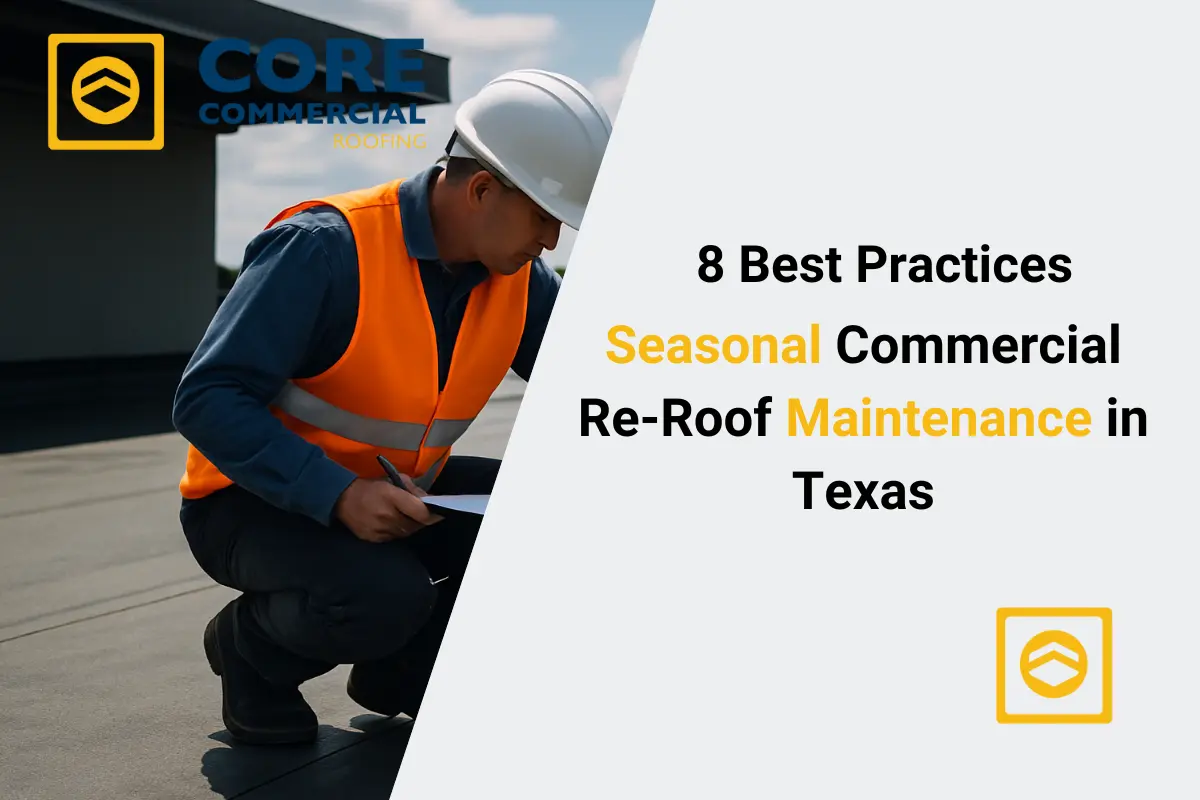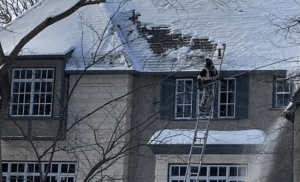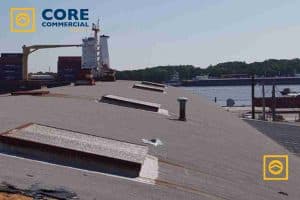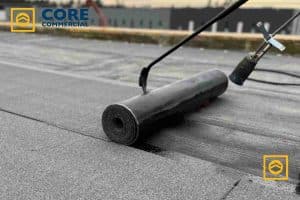In the harsh Texas climate, your commercial roof is more than just a structure. It’s your first line of defense against extreme heat, violent storms, and rapid weather changes. Without seasonal maintenance, even the strongest roof systems can fail early. This article walks you through the 8 most effective seasonal maintenance practices to keep your commercial roof in excellent condition year-round. From tackling storm debris to preparing for scorching summer heat, we’ll show you how to avoid expensive repairs, extend your roof’s life, and protect your business operations from sudden disruptions. Whether you manage a warehouse in Houston or an office building in Dallas, these simple, proactive steps are your best investment.
Table of Contents
1. Inspect After Every Major Storm
Why It Matters
Texas weather can go from sunny skies to hail and high winds in a flash. Tornadoes, hurricanes, and hailstorms aren’t rare events; they’re regular seasonal threats. That means storm damage isn’t a possibility; it’s a probability.
What You Should Do
After every major weather event:
- Walk the roof (or hire a pro) to check for visible damage like torn membranes, punctures, or shifted panels.
- Look for signs of water entry inside your building, ceiling stains, drips, or musty smells.
- Take pictures and write notes for insurance purposes if you spot damage.
Real Benefit
By catching damage early, you can fix small issues before they become expensive repairs that shut down operations or cause safety hazards.
2. Clean Gutters and Drains Every Season
Why It Matters
Clogged drainage systems are one of the top causes of roof failure. When water can’t drain, it pools, and that standing water wears down materials and seeps into cracks.
What You Should Do
At the start of each season:
- Remove leaves, dirt, and debris from gutters and downspouts.
- Make sure scuppers and internal drains are clear and flowing.
- Install leaf guards or screens if your roof is under trees.
Real Benefit
Clean drainage prevents leaks and avoids the kind of water damage that leads to interior mold, electrical issues, and roofing system breakdown.
3. Schedule Routine Professional Roof Inspections
Why It Matters
Just because you can’t see damage doesn’t mean it’s not there. UV rays, temperature swings, and foot traffic all cause slow wear that builds up over time.
What You Should Do
- Hire a licensed commercial roofing contractor to inspect your roof at least twice a year, once in spring, once in fall.
- Ask for a detailed report with photos and notes on wear areas, repairs, and recommendations.
Real Benefit
Professional eyes spot problems you miss, like early membrane shrinkage, hidden moisture, or fastener loosening. Regular inspections keep warranties valid and ensure compliance with safety codes.
You may check: commercial roof cost per square foot
4. Check Flashing and Sealants in the Spring and Fall
Why It Matters
Flashing (the metal trim around roof edges and equipment) and sealants (like caulk or rubber gaskets) take a beating from Texas heat and UV exposure. They crack, peel, and separate over time.
What You Should Do
- Check all flashing joints, HVAC curbs, and skylights for gaps or peeling sealant.
- Reapply or reseal where needed using compatible materials recommended by your roof manufacturer.
- Pay special attention after a summer of 100°F+ days or a winter freeze.
Real Benefit
Maintaining seals keeps water out and helps your insulation and HVAC systems work efficiently, saving on energy costs and avoiding costly water entry.
5. Monitor Roof Traffic and Footprint Damage
Why It Matters
HVAC techs, electricians, and service crews often walk on your roof, and one wrong step can crack a panel, puncture a membrane, or knock over sensitive equipment.
What You Should Do
- Require anyone accessing the roof to use designated walk paths or mats.
- Install walk pads near units or areas of frequent traffic.
- Log all roof access and inspections.
Real Benefit
By reducing physical damage, you reduce the chances of unexpected leaks and preserve the long-term integrity of your roof, especially critical in flat-roof systems common in Texas.
6. Trim Overhanging Trees Before Storm Season
Why It Matters
Texas storms are notorious for strong winds. Overhanging tree limbs can break and smash into roofing systems, rip off vents, or cause gutter collapse. Falling leaves also clog drains.
What You Should Do
- Cut back branches at least 6 to 10 feet from the roof edge.
- Remove any dead or weak trees near the building perimeter.
- Schedule trimming in late winter or early spring, before summer storms roll in.
Real Benefit
This simple landscaping measure saves thousands in repair costs and makes your entire roofing structure less vulnerable to seasonal wind and debris damage.
7. Address Small Leaks Before They Spread
Why It Matters
One small leak can turn into widespread water damage if left untreated. Moisture spreads under insulation and into ceilings, causing rot, mold, and business interruptions.
What You Should Do
- Investigate all water stains, ceiling drips, or musty smells immediately.
- Don’t just patch – trace the leak to its source and fully repair the affected area.
- Use thermal imaging or moisture detection tools for hidden leaks.
Real Benefit
Fixing leaks early keeps your interior safe, protects inventory and equipment, and prevents minor issues from spiraling into thousands in damage and lost business time.
8. Document Every Repair and Maintenance Visit
Why It Matters
When something goes wrong, the first question is: “What’s been done already?” Without records, you lose time and money trying to figure it out.
What You Should Do
- Keep a digital log of every inspection, repair, and maintenance task.
- Include dates, service provider info, work performed, photos, and material types.
- Store records in cloud-based systems for quick access and sharing.
Real Benefit
With detailed documentation, you can make smarter maintenance decisions, file faster insurance claims, and avoid duplicate services. It also helps you budget for future replacements or upgrades.
Final Thoughts: Maintenance Is Your Roof’s Insurance Policy
A commercial roof in Texas faces more environmental stress than most regions in the U.S. The key to long-term performance isn’t a one-time investment; it’s consistent, seasonal care. These eight best practices aren’t complicated or expensive, but they deliver serious protection, peace of mind, and long-term savings.
By catching issues early, cleaning proactively, and documenting carefully, you avoid the most costly mistakes: business interruptions, liability risks, emergency replacements, and failed inspections. Whether you run a retail strip in San Antonio or a manufacturing facility in Fort Worth, your roof maintenance strategy should be just as strong as your business plan.
Core Commercial Roofing & Coatings emphasizes that consistent, proactive maintenance is the only effective defense against the harsh Texas climate. By implementing these seasonal best practices, you are not just performing upkeep; you are actively investing in the longevity and reliability of your commercial asset, securing its performance for years to come.r
FAQs
How Often Should a Texas Commercial Roof Be Inspected?
Core Commercial Roofing & Coatings recommends inspecting your commercial roof at least twice per year, ideally in the spring and fall. Given the volatility of Texas weather, an additional inspection is critical immediately after every major storm (hail, high winds, or heavy rain). These routine checks catch slow wear from UV rays and temperature shifts, while post-storm inspections ensure small punctures or damage to flashing are fixed before they lead to catastrophic leaks, preserving your roof’s warranty and integrity.
What Is the Best Season for Commercial Roof Service in Texas?
The spring (March-May) and fall (September-November) are the optimal seasons for comprehensive commercial roof service in Texas. These mild-weather windows offer ideal temperatures for membrane adhesion and sealant curing, allowing for thorough inspections, preventive repairs, and cleaning before the extreme stress of summer’s scorching heat or the severe weather of spring storm season. Scheduling during these times allows Core Commercial Roofing & Coatings to address existing damage proactively.
How Do I Spot Storm or Hail Damage on a Texas Flat Roof?
Spotting storm damage on a flat commercial roof requires looking for subtle, often hidden signs. Key indicators include visible impact marks on metal components (like vents or flashing), bruising or soft spots on the roofing membrane, cracks or splits in the membrane or seams, and granules accumulating in gutters or downspouts. Any sign of water entry inside, such as ceiling stains or musty odors, also points to a breach that must be addressed immediately by a professional.
Why Is Cleaning Drains Critical for Texas Commercial Roofs?
Cleaning gutters, scuppers, and internal drains is the single most critical maintenance task to prevent premature roof failure in Texas. When these drainage systems are clogged with debris, water cannot properly escape, leading to ponding or standing water on the flat roof surface. This excessive standing water accelerates the breakdown of the roofing material, compromises flashing seals, and adds significant structural weight, which can lead to leaks, premature membrane failure, and costly damage to the decking and insulation below.
Should I Trim Trees Near My Texas Business Roof Before Storms?
Yes, absolutely. Trimming overhanging trees is a proactive measure that saves thousands in potential storm repair costs. Core Commercial Roofing & Coatings strongly advises cutting back branches a minimum of 6 to 10 feet from the roof’s edge, and removing any dead or weak limbs. Strong Texas winds can turn loose or weak branches into damaging projectiles, leading to membrane punctures, gutter collapse, or damage to rooftop equipment. Scheduling this in late winter or early spring is ideal.
How Can a Maintenance Log Help My Texas Commercial Roof Budget?
A detailed maintenance log is an essential financial tool, acting as your roof’s complete service history. By documenting every inspection, repair, material used, and service date, you can establish clear patterns of wear, predict future repair needs, and create accurate capital expenditure budgets. This documentation is also critical for validating manufacturer warranties and streamlining the process of filing insurance claims after a storm, ensuring you receive maximum coverage and avoid costly out-of-pocket expenses.
What Are Early Leak Signs Inside Texas Offices After Rain?
Early signs of a leak inside an office space often manifest before the leak becomes a drip. Be vigilant for discolored, brown, or yellow water stains on ceiling tiles or walls, peeling or bubbling paint (especially near the top of walls), and musty or mildew odors indicating trapped moisture behind the drywall. A sagging or soft ceiling panel is a sign of significant water accumulation and requires immediate professional attention to prevent collapse and further damage to inventory and electronics.
Is a Roof Maintenance Plan Worth It for Texas Warehouses?
Absolutely. For large Texas warehouses, where the roof is a massive, critical asset protecting valuable inventory and complex operations, a professional maintenance plan is a non-negotiable investment. A plan from Core Commercial Roofing & Coatings ensures compliance with warranty requirements, significantly extends the roof’s useful life by addressing minor issues like flashing separation and membrane stress, and drastically reduces the risk of catastrophic business interruption from unexpected emergency leaks.
How Does Texas Heat Affect Commercial Roof Materials Long-Term?
Extreme Texas heat and intense UV radiation are primary drivers of roof material degradation. The constant thermal stress causes materials to expand and contract repeatedly, leading to seam separation, cracking, and blistering in membranes like TPO, EPDM, and modified bitumen. UV rays break down the chemical bonds in roofing materials, accelerating the aging process and causing protective layers, like granules, to shed prematurely, which ultimately reduces the roof’s lifespan and reflectivity.
Can Foot Traffic Damage My Flat Commercial Roof in Texas?
Yes, unmanaged foot traffic from HVAC technicians, plumbers, or service crews is a common cause of premature roof failure, especially on flat systems. Core Commercial Roofing & Coatings advises that physical movement can lead to punctures, abrasions, and the loosening of seals around rooftop penetrations (HVAC curbs, pipes). To prevent this, implement a policy requiring the use of designated walk pads or traffic mats near equipment and logged access for all roof visitors.






